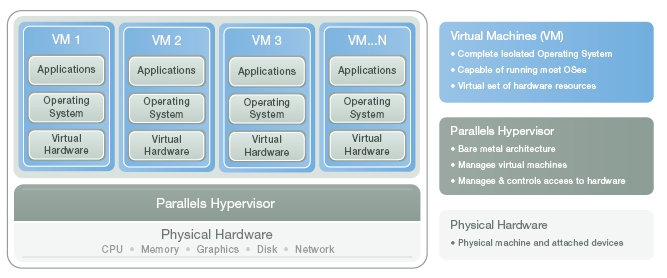Parallels releases its Hypervisor -- on the Mac

Today, virtualization vendor Parallels released the first version of its Server hypervisor for x86 hardware. The surprising thing about it is that it chose to go to release with its Mac version first.
Parallels first came to market with its desktop-based virtualization products for Linux, Windows and Mac back in 2005 and 2006. With the 2007 acquisition and merger of Parallels by SWSoft, the makers of Virtuozzo, Parallels has the distinction of being the only virtualization vendor to offer a multi-platform bare-metal monolithic hypervisor (like VMWare's ESX, HP's nPar/vPar, Sun's LDOM or IBM's zVM/ LPAR) a "light hypervisor" (a la Xen and Microsoft Hyper-V) as well as a "containered" homogeneous solution for Linux and Windows (such as Sun's Solaris Containers) under one seamless management platform, PIM -- Parallels Infrastructure Manager, formerly known as Virtuozzo Control Center.
Click on the "Read the rest of this entry" link below for more.
Released today for Mac Server and Desktop systems, and currently in beta for generic x86 hardware, Parallels Server introduces a number of industry firsts. One, it provides a choice of either a "bare-metal" configuration similar to VMWare ESX in which no OS sits at the supervisory layer and all guest VMs run completely isolated, or with a "light" hypervisor much like the way Xen or Hyper-V uses a "Parent" OS to provide the device driver layer.
Parallels is also the first vendor to support live migration of fully virtualized guests to containerized guests using a built-in conversion facility. This would allow the flexibility of testing of a virtualized application using full hypervisor, but "scale-out" possibilities on containers.
Containers, unlike fully virtualized systems like Parallels Server, VMWare ESX, Xen and Hyper-V share a common kernel, and run as "personalities" or "virtual environments"of the same Operating System. In other words, Linux can be split up into multiple flavors of Linux (Redhat host running Ubuntu, Red Hat and SuSE guests) and Windows can run the same version of itself in isolated instances with their own unique applications and settings. The benefit of such an approach is the ability to run separate instances of I/O intensive applications such as databases without the overhead associated with full virtualization. Want to run one version of Exchange Server or Oracle alongside another on the same box on a shared kernel environment? No problem.
Virtuozzo containers are available for use in a Free Software/GPL version known as OpenVZ, which is distributed as a modified Linux kernel source tree. The Windows version is sold only as a commercial product.
Parallels Server is also the first virtualization product in the industry to support the all of the new Intel VT-X and VT-D features of the latest Core Duo and Xeon processors, which can accelerate VM's greatly on hardware that support it --- Parallels claims up to 150 percent performance improvements on VMs hosted on such systems. VT-D in particular is of particular interest, in that it can allow specific hardware resources, such as network cards, to be dedicated to a particular VM, allowing for much finer granularity of resource allocation than competing products. Parallels also is the first virtualization product to support Intel Trusted Execution Technology (TXT) which secures the system boot process from malware attacks.
Naturally, because the first version of Parallels Server is for Mac, it will allow the virtualization of Mac OS X Server on Mac hardware, in addition to 50-some odd versions of Linux, Windows, and UNIX. Due to legal reasons and restrictions Apple has placed on its use, Leopard and Tiger Mac OS X desktop versions are still not supported as a VM. Mac OS X Server will only be supported as a Virtual Machine on the Macintosh version of the product.
What's your take on Parallels Server? Talk back and let me know.
